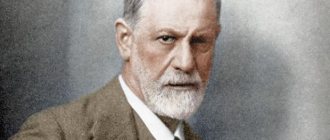Alfred Adler is a famous Austrian psychiatrist and the founder of individual psychology. At one time, his “sharp” views on the psychoanalytic theory of personality turned Adler from Freud’s close assistant into his ardent opponent. Complete disagreement with Freud's views led to a split in the Vienna Psychoanalytic Society and the emergence of a new direction - individual personality psychology.
Content
- Striving for superiority and feelings of inferiority
- Sense of Community
- Compensation and overcompensation
- The connection between birth order and human personality
- What are the differences between A. Adler’s theory and S. Freud’s theory?
Alfred Adler (1870-1937) - Austrian psychologist, psychiatrist, one of the predecessors of neo-Freudianism, founder of individual psychology. At first he joined the supporters of Z. Freud, then he founded his own school.
According to Adler, human behavior is determined primarily not by biological, but by social factors. He introduced the concept of social interest. Social interest is an innate potential aimed at cooperation with other people and at achieving personal and social goals. Such interest develops in childhood, as experience accumulates.
Creative Self
Creative "I"
Adler, like Freud, emphasized the importance of early experience in the formation of adult personality
The main constructor of Adler's theory is the concept of the creative self, in relation to which all other constructs occupy a subordinate position. The scientist argued that life style is formed under the influence of the creative abilities of the individual. People are responsible for who they become and how they behave. Responsible for the purpose of life, creative power determines the method of achieving the goal and contributes to the development of social interest. It also influences perception, memory, fantasies, dreams and makes a person a free individual.
Adler did not deny the influence of heredity and environment on the formation of personality, but people are something more than the results of the action of heredity and environment. A person uses heredity and environment as building material to form the building of personality, but with his own style.
Creative power is the result of a long history of evolution, and people, having it, are therefore people. People are the masters of their own destiny.
Striving for superiority and feelings of inferiority
Adler’s concept is based on the idea of a single driving force that underlies the structure of the personality and directs all its resources to achieve the most important goal, which gives meaning to the entire being of the individual. Such a goal, according to Adler, is the desire for superiority or self-affirmation.
The desire for superiority (self-affirmation) is the desire to overcome one’s own shortcomings and realize one’s fullest potential.
It is this goal that subordinates the entire movement towards more complete development and fulfillment, the realization of our Self. Adler was convinced that this desire for superiority is an innate factor, its traces can be easily detected in all aspects of personality manifestation.
The true driving force of personality is a generalized feeling of inferiority. A feeling of inferiority is a human experience associated with a feeling of being inferior and of little value; associated with organic and functional inferiority of a person.
Strong feelings of inferiority, or inferiority complex, can make positive growth and development difficult. However, a moderate feeling of inferiority encourages the child to grow, to become as strong or even stronger than others, to strive for improvement, for superiority, for the development of his abilities. Those. the desire to overcome the inferiority complex starts the process of human development.
Initially, Adler attributed this feeling of inferiority to bodily defects. A child with hereditary organic defects will try to compensate for them through more intensive development of the defective function. For example, a child who stutters with the help of speech therapy can become a great speaker, a child with weak limbs after intense physical exercise becomes a good athlete or dancer.
Adler later expanded the concept of inferiority to include all types of physical, mental or social defects - real or imagined. He also believed that the weakness and helplessness of a child, his dependence on the environment leads to the emergence of a feeling of inferiority, so familiar to every person. The child is aware of his inferiority and the need to overcome the disadvantage, but at the same time he is driven by an innate desire for superiority. As a result, such a process moves the individual towards greater perfection and realization.
Links
- Dinkmeyer, D.C., Pugh, W.L., & Dinkmeyer, D.C., Jr. (1979). Adlerian counseling and psychotherapy
. Monterey, CA: Brooks/Cole. - Fall, K. A., Holden, J. M., & Marquis, A. (2002). Theoretical models of counseling and psychotherapy
. New York: Brunner-Routledge. - Hoffman, E. (1994). The Striving for Self: Alfred Adler and the Foundation of Individual Psychology
. Reading, MA: Addison-Wesley Publishing. - Mosak, H.H., and Di Pietro, R. (2006). Early Memories: Method and Application of Interpretation
. New York: Routledge. - Oberst, U. E., & Stewart, A. E. (2003). Adlerian Psychotherapy: An Advanced Approach to Individual Psychology
. New York: Brunner-Routledge.
Sense of Community
Lifestyle is a system of purposeful aspirations developed in childhood, in which the need to achieve superiority and self-affirmation is realized as compensation for an “inferiority complex.” It is the determinant that defines and systematizes human experience. It is closely related to the sense of community, one of the three innate unconscious feelings that make up the structure of the Self.
The sense of community (public interest) is a sense of human solidarity, the connection of man to man, an expanded sense of fellowship in human society, an interest in the ideal society of all mankind as the ultimate goal of evolution. Collaboration is one manifestation of a sense of community.
The sense of community is a kind of core that holds the entire structure of a lifestyle, determines its content and direction. Although this feeling is innate, it may remain undeveloped, which becomes the basis of an antisocial lifestyle, the cause of neuroses and conflicts.
The development of a sense of community is associated with close adults who surround the child from childhood, primarily with the mother. Rejected children, growing up with cold, isolated mothers, do not develop a sense of community.
It does not develop in spoiled children either. The level of development of a sense of community determines the system of ideas about oneself and the world that is created by each person. The inadequacy of this system impedes personal growth and provokes the development of neuroses.
By shaping his life style, a person himself is actually the creator of his personality, which he creates from the raw material of heredity and experience. If a sense of community determines the direction of life, its style, then two other innate and unconscious feelings - inferiority and the desire for superiority - are peculiar carriers of the energy necessary for personality development. Both of these feelings are positive, they are incentives for personal growth and self-improvement.
Thus, according to Adler, human life is determined by the struggle of two basic needs: the need for power and superiority and the need for affection and belonging to a social group.
If the feeling of inferiority affects a person, causing him to desire to overcome his shortcomings, then the desire for superiority causes the desire to be the best - not only to overcome the disadvantage, but also to become the most skillful and knowledgeable.
These feelings, from Adler’s point of view, stimulate not only individual development, but also the development of society as a whole. There is also a special mechanism that helps the development of these feelings - compensation.
Subject of individual psychology
The name of Adler’s theory “Individual Psychology” comes from the Latin word individum (indivisible) and expresses the idea of the integrity of people’s mental life, in particular, the absence of boundaries and contradictions between consciousness and subconsciousness. A red thread running through the behavior and lifestyle of any person is his life style, aimed at realizing life goals (in later works - the meaning of life).
The purpose, meaning and style of a person’s life are formed in the first 3-5 years and are determined by the characteristics of family upbringing. The subject of study of individual psychology is the illumination of problems of the soul and body.
Compensation and overcompensation
Compensation is an increased, compensatory development of physical, mental and personal components, compensating for a certain deficiency, real or imaginary.
Adler identified 4 main types of compensation: 1. incomplete compensation; 2. full compensation; 3. overcompensation; 4. imaginary compensation, or going into illness.
He believed that a developed sense of community , determining the social style of life, enables the child to create a fairly adequate scheme of apperception. At the same time, children with incomplete compensation feel less of their inferiority, since they can compensate with the help of other people, with the help of peers from whom they do not feel isolated. This is especially important for physical defects, which often do not allow for full compensation and thus can cause the child to be isolated and stop his personal growth.
Incomplete compensation in children with an undeveloped sense of community leads to the emergence of an inferiority complex, which makes the apperception scheme inadequate, changes the life style, making the child anxious, insecure, envious, conformist and tense.
Overcompensation is the process of restructuring the body in response to damage or harmful influence, causing defensive reactions that are much more energetic and stronger than those needed to paralyze the immediate danger.
In the case of overcompensation with a developed sense of community, a person tries to use his knowledge and skills to benefit people; his desire for superiority does not turn into aggression. With an undeveloped sense of community, neurotic complexes begin to form in a child in early childhood, which lead to deviations in personality development.
In the case of overcompensation in children with an undeveloped sense of community, the desire for self-improvement is transformed into a neurotic complex of power, dominance and mastery. Such people use their knowledge to gain power over people, to enslave them, thinking not about the benefit of others, but about their own benefits. In this case, an inadequate scheme of apperception is formed, changing the lifestyle. These people suspect those around them of wanting to take away their power and therefore become suspicious, cruel, vindictive, tyrants and aggressors.
Full compensation occurs when the individual has a developed sense of community; the defect is recognized as its own individuality; the desire for superiority is expressed in the desire for the standards of the majority, the desire to overcome limitations through a positive lifestyle, nothing more. A person does not strive for superiority; his achievement is to be no worse than the majority.
The inability to overcome one’s defects, especially physical ones, often leads to imaginary compensation , in which a child (and later an adult) begins to exploit his disadvantage, trying to extract privileges from the attention and sympathy with which he is surrounded. This type of compensation is imperfect: it stops personal growth, forming an inadequate, envious, selfish personality.
Links
- Individual psychology // Big Encyclopedic Dictionary (Russian). - 2000. // Big Encyclopedic Dictionary. - 2000.
- Adler's individual psychology // 1. Small medical encyclopedia. — M.: Medical encyclopedia. 1991-96 2. First aid. - M.: Great Russian Encyclopedia. 1994 3. Encyclopedic Dictionary of Medical Terms. - M.: Soviet Encyclopedia. - 1982-1984 (Russian). // [dic.academic.ru/contents.nsf/enc_medicine/ Medical encyclopedia]
- B. D. Karvasarsky.
Individual psychology // Psychotherapeutic encyclopedia. - St. Petersburg: Peter (Russian). - 2000. // Psychotherapeutic Encyclopedia. - S.-Pb. : St. Petersburg: B. D. Karvasarsky. - 2000.
The connection between birth order and human personality
Many people wonder how birth order affects the character and future fate of a child. While exploring the childhood experiences of his patients, Adler became interested in the connection between birth order and human personality. Depending on how the child was born, he may have certain characteristics. A. Adler discovered that older, middle and younger children, due to differences in their position in the family, have different social experiences and, as a result, have different personality structures.
Alfred Adler identified the following ordinal positions of a child in a family: only child, eldest child in the family, middle child, youngest of two children, youngest of three or more children. So, let's consider Adler's birth order, and the traits that will belong to children in the family, depending on the birth order.
The only child in the family
For the only child in the family, the most important task is to understand adults. By solving this problem, he develops his ability to understand other people. It is characterized by a heightened sense of good and evil and high motivation to achieve. He loves solving problems and finding different ways to solve them.
Only children feel unique. They demand a lot from life and strive to meet the expectations of their parents. They are characterized by a high level of self-esteem. Only children have more opportunities for intellectual improvement.
There is a risk of attachment, learned helplessness. Being in the power of parental care, the child is practically never left to himself. He has little opportunity to independently build his relationships with others. Depending on the degree of parental care, two types of only children are distinguished: early maturing and “mama’s boy”.
The first child in the family, i.e. firstborn
The eldest child goes through three stages in his development: 1. He is the only one, unique, in the focus of his parents’ attention, in a privileged position. 2. With the birth of the youngest child, the situation changes dramatically. If the eldest is not 5-6 years old at this time, then the birth of a brother or sister can cause severe stress. Parents switch to the baby, the older child loses power over them. Envy and competition between children are possible, and this reaction of the first child to the appearance of the younger one is stronger if the second child is of the same sex. 3. At the third stage, the child finds a way out of the current situation. He believes that he should be stronger and smarter than the younger child. This decision is reinforced by the behavior of the parents: they understand that the eldest is given too little time and attention. Therefore, they tell him that compared to a baby, he is already smart enough to do many things on his own, without the help of adults.
Thus, the eldest children in the family are the center of attention for some time - but only until the next child appears, who will now attract all the attention of the parents. Therefore, the first-born may begin to feel insecure and hostile, losing his previous sense of security. The result of these changes can also be authoritarianism and conservatism, a rigid desire to maintain order by any means. Adler suggested that it is often the first-born in the family who become criminals, neurotics and perverts.
Older children follow the rules, strive for perfection, success and most often achieve it, and if not, then they give up what they started. These are usually obedient, rule-following children. They are conscientious, serious, stubborn, responsible, and the sense of responsibility may be too high. They are intolerant of other people's mistakes and at the same time very sensitive to the comments of others and changes in relationships.
Middle child in the family
The position of the middle child in birth order is the least studied; Apparently, it is these children who most often have difficulties with self-determination, due to the fact that they are both older and younger and therefore combine the features of both.
Lack of attention from parents often results in the middle child feeling abandoned and therefore sometimes picking up annoying, attention-seeking habits. Some researchers believe that middle children learn to get along with everyone, becoming friendly and tactful towards others.
Second child in the family (younger of two children)
According to Adler, the second child is often ambitious, rebellious and jealous: after all, he is always faced with the task of not only keeping up with, but also surpassing his older brother or sister. Adler believed that it was the second child who was better adapted to life than the older or younger child. After all, younger children, as a rule, are spoiled in the family, and therefore they are more likely to have problems than others. They are more self-oriented than other-oriented and do not particularly strive to meet the expectations of others.
This child is the complete opposite of the older one. He is characterized by independence and optimism. The younger of the two children shifts responsibility for everything that happens to the others. He is manipulative in his relationships with people. It is difficult for him to keep up with his elder, who is academically oriented, so he decides to beat him in another field where he is not strong (usually sports or art).
Youngest of three or more children
To develop relationships with others, especially with their own brothers and sisters, they can either pretend to be children all their lives, or find a way to get ahead of others. These children may be the luckiest of all. They are creative individuals and are often incomprehensible to others. Their gaze is directed to the future. They often make good leaders.
By the time the youngest child was born, parents could already have formed their own views on upbringing. Therefore, it can be assumed that in relation to the younger, the tactics of educational influence will be more consistent than in relation to the older. Therefore, the youngest of several children will be more emotionally stable than the older children.
Biography of the Austrian psychologist
Alfred Adler was born into a poor Jewish family. Besides him, his parents had five more children. The older brother, ironically, was named Sigmund. The older brother grew up physically healthy and successful; he became an entrepreneur and constantly helped the family. But Alfred was not at all different in physical health.
He suffered from rickets, which left him unable to walk for a long time. He also had severe pneumonia with many complications. Several times the seriously ill child almost died.
Despite his illnesses, Alfred tried to keep up with his peers and even went outside to play with them. Friends did not consider him somehow inferior, and with them he was even better than at home with his parents. At the same time, Alfred tried his best to overcome his shortcomings, which he succeeded in doing.
For example, the road to school passed by a fence behind which, as the children believed, there was a cemetery. Alfred was very afraid of cemeteries, and one day he decided to overcome his fear. He climbed over the fence and walked around the cemetery several times until he was sure that the fear had disappeared. A little later he found out that there was not a cemetery there, but just an abandoned yard.
Due to his illnesses, as well as his daydreaming, Alfred's performance at school was poor. So much so that the teacher advised him to quit school and go to study to become a shoemaker. This made the boy very angry. He gathered his will into a fist, began to study and soon became the best student in the class. After school, he even entered the University of Vienna and began to study medicine, after which he first worked as a general practitioner.
At the university, he also became interested in socialism and began to participate in student political meetings. At one of them, he met a student from Russia, Raisa Epstein, who soon became his wife. Subsequently, Raisa Epstein proved herself to be an active activist in feminism.
Alfred Adler initially became interested in the ideas of Sigmund Freud; in the press he actively defended Freud’s book “The Interpretation of Dreams,” which touched the author of the book himself.
However, Adler’s differences with the then “guru of psychoanalysis” began already at that time. Thus, he did not recognize the dominant role of childhood sexuality in the development of the human psyche.
Subsequently, the discrepancies between his views and Freud's theory became even greater. Freud was very offended if any of the psychologists, and even those who called themselves psychoanalysts, disagreed with him on something. Freud believed that there could only be one psychoanalysis, and it was the one that he himself developed. Freud often called his opponents paranoid and considered them closet homosexuals. Therefore, there could be no friendship or cooperation between him and Adler.
Subsequently, Adler, by special invitation, arrived in the United States, where he ultimately stayed forever. He became a professor at Columbia University and lectured at other scientific organizations. At first, he came to Vienna for the summer, but after the Nazis came to power in Germany and occupied Austria, he could no longer appear in his homeland. All his followers also had to urgently emigrate.
In 1937, having arrived in Aberdeen, Scotland to lecture, Adler suddenly died of a heart attack.
Adler's ideas
Adler wanted to create a psychology close to real life, which would allow us to understand other people by their biographies, which are always different.
The works he published from 1920 onwards, as well as his lectures, were intended to make his psychology accessible to everyone and make it generally understandable. He gave a series of lectures in Vienna in the 1920s and published them in 1927 under the title Knowledge of Human Nature.
The period of World War I was the era in which individual psychology developed. As part of school reform in the Austrian capital, Adler and his employees opened about 30 educational and counseling institutions. In 1920, he was appointed director of the first Viennese clinic dedicated to child psychology, and taught pedagogy in the city. With the publication of “The Practice and Theory of Individual Psychology” (1930), which contained lectures for an introduction to psychotherapy for doctors, psychologists and teachers, Adler began to reveal his theory in more detail.
Behaviorism, 1912
The earliest direction that reduces psychology to reflexes and is still relevant today is behaviorism. The prerequisites for its development are the studies of the American psychologist and educator Edward Lee Thorndike on animal behavior, which were based on problems of skill. In understanding human psychology, the concept of E. L. Thorndike was transferred by the American psychologist John Brodes Watson, who in 1912 reflected the principles of the new direction of psychology in his article. In Russia, I. P. Pavlov and V. M. Bekhterev, who studied reflexology, are considered representatives of behaviorism or behavioral psychology.
The initial methodological position of psychologists in this area is to provide the client with control over his actions, which allows for changes in his behavior. It is behavior, and not consciousness, that is considered the subject of psychology. Behavior is characterized by responsive movements (reactions) of the body to external influences (stimuli) of the environment. Adherents of the behavioral direction base their work on the study of the conditions for the emergence, consolidation, and disappearance of habits and skills. This approach is characterized by scientific pragmatism, control of results and the reduction of consciousness to physiological processes, which serves as a reason for criticism from representatives of personality-oriented trends.









